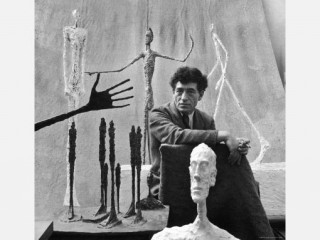
Alberto Giacometti biography
Date of birth : 1901-10-10
Date of death : 1966-01-12
Birthplace : Stampa, Switzerland
Nationality : Swiss
Category : Arts and Entertainment
Last modified : 2010-11-15
Credited as : Sculptor and painter, ,
The recurring themes of the Swiss sculptor and painter Alberto Giacometti are time, movement, and transparence. He is best known for his elongated figural structures.
The son of a painter, Alberto Giacometti was born in Stampa on Oct. 10, 1901. He began to draw and model at an early age, and in 1919 he enrolled at the école des Arts-et-Métiers in Geneva. He traveled in Italy in 1920-1921. He studied with the sculptor Emile Antoine Bourdelle at the Académie de la Grande-Chaumière in Paris from 1922 to 1925. After sharing a studio in Paris with his brother Diego from 1925 to 1927, Giacometti set up on his own.
Giacometti's early work derived from cubist (Torso, 1925), African, and Cycladic sculpture (Spoon Woman, 1926). But by 1928 he began to develop a personal treatment of the medium, moving to more original ideas—in part a result of his meeting that year with the surrealists, with whom he later became affiliated. In his Man and Reclining Woman Who Dreams (both 1929) he created open structures concerned principally with establishing a viable language of form and solving the technical difficulties of armature and support.
Giacometti occasionally returned to figural themes in the 1930s and early 1940s, as in Nude, Femme qui marche (1933-1934), the first of the elongated torsos, and Woman
with Chariot I (1942-1943). The latter work, evocative and immobile, is an extension of the expressive qualities stated in the major work of this period: the surrealist constructions of 1929 to 1945.
These constructions imply or state movement— Suspended Ball (1930-1931) and the Captured Hand (1932)—and sometimes border on the fantastic, as in the well-known Palace at 4 A.M. (1932-1933). They are quasirealistic, as in the Woman with Her Throat Cut (1932), and at times allusive, as in the Project for a Passage (1932). In Hands Holding the Void (1934) Giacometti brought together the figural and the fantastic and prefigured the metaphysics articulated in his postwar work.
Giacometti lived in Switzerland from 1942 until 1945, when he returned to Paris. In Switzerland he met Annette Arm, who became his wife.
Giacometti's work after 1945 was almost exclusively figural, ranging from numerous portraits of his brother and his wife to sculptures of the anonymous and universal man, pointing, standing, or walking. He found a new means of modeling and painting. In his sculpture small, anonymous patches are laid over a skeletal structure; in his paintings he used short nervous lines and monochromatic low-keyed hues. In both mediums he employed elongated proportions, either in individual parts of the figure or throughout the body as a whole.
Giacometti's compositions narrowed down to four themes: one person in an environment, as in Walking Quietly under the Rain (1949), or several people encountering each other, as in City Square (1948); single figures gesturing, such as the Man Pointing (1947); figures placed atop a pedestal or support, such as Chariot (1950); and single, gazing portraits that concentrate on the head, as in Portrait of Diego (1954) and Monumental Head (1960). Regarding this last theme, Giacometti once remarked that "all the rest of the head is a prop for the gaze." He died in Chur, Switzerland, on Jan. 12, 1966.
The most recent and thorough monograph on Giacometti is David Sylvester, Alberto Giacometti (1965). Peter Selz, Alberto Giacometti (1965), the exhibition catalog for the Museum of Modern Art, is short but useful. The most profound interpretation of Giacometti's imagery can be found in two essays of Jean Paul Sartre, "The Quest for the Absolute" (1948) and "The Paintings of Giacometti" (1954), both translated into English and published in Sartre's Essays in Aesthetics (1964). For another interpretation see Jacques Dupin, Alberto Giacometti (trans. 1963).
Juliet, Charles, Giacometti, Paris: Hazan, 1985.
















